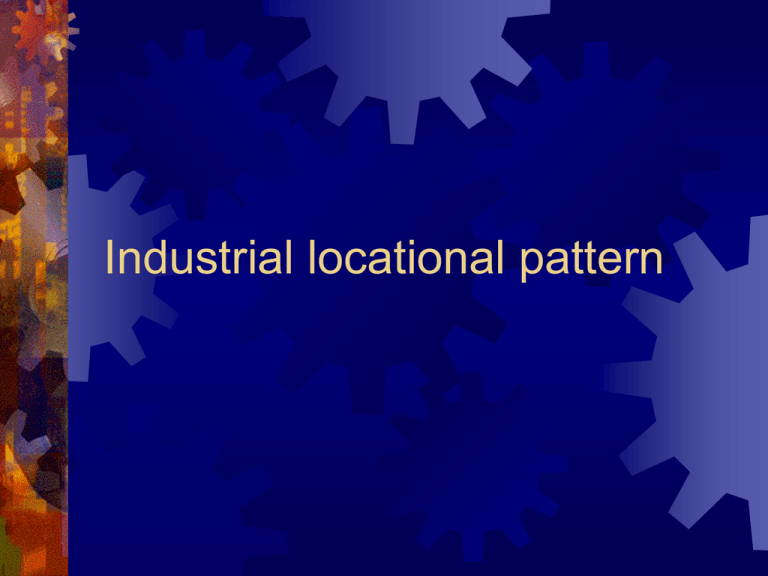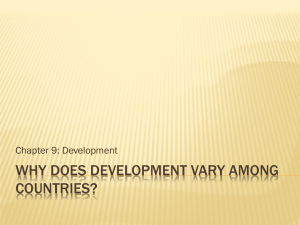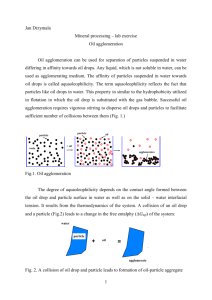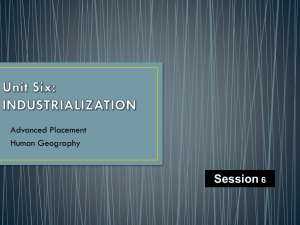Industrial locationa..
advertisement

Industrial locational pattern Agglomeration Case: industrial estates in HK Industrial land use Use of land for industrial activities Old industrial areas Hong Kong Science Park Yuen Long Industrial Estate Tsuen Wan Lai Chi Kok Industrial estates Cyberport Dofor For you example, know what industrial are the Areas hightechnology differences estates are more between spacious, old industry ofindustrial lower density areasand andmore industrial well-planned. estates? Tai Po Industrial Estate Kwun Tong Tseung Kwan O Industrial Estate The Exercise Key HK industrial estates in Hong Kong & space cost curve analysis The answer key a(i) X – I (brewing of beer) Y – B or H (concrete panels/ tempered glass) Z – F (dairy products & soft drinks) The answer key a(ii) industries in the industrial estates: - occupies large space / larger factory buildings - not produced in flatted factories - modern capital – and technologyintensive industries The answer key b - lower land acquisition costs - land converted from farm lands - inland site – no need for reclamation from the sea as in the case of the two other estates The answer key b (con’t) - cargo loading and storing facilities (as at waterfront sites of Tseung Kwan O) not required - only road transport service provided (no water transport) The answer key c - industrial estates are located in suburban areas - cost curve of the industries declines with distance from city centre – mainly due to lower land price at suburban locations - as a result of less competition or demand for space The answer key c (con’t) - revenue curve of the industries remains constant over space - no spatial variation in the price of product - uniform price of the finished products in the local market The answer key c (con’t) - or no local spatial variation in price element for export-oriented industries - whilst the higher freight charges of road transport to and from the port for these suburban industries are relatively insignificant The answer key d.- better planning provides more open space and road network - reduction of congestion problems - sewage disposal facilities / sewage treatment plant reduce water pollution - strict control on types of industries / emissions - location distant from housing areas reduces environmental impact Industrial agglomeration What & why? Industrial agglomeration? industries can obtain benefits from clustering together as described as internal and external economies (refer to the discussion on the part Weber’s industrial model – the 2nd deviating factor) Industrial agglomeration? Agglomeration emerges as a phenomenon which demonstrates a spatial clustering or concentration of industrial activities in a relatively small region; As a process, agglomeration triggers a snowball effect to further attracts manufacturing firms / plants to cluster in that relatively small area over time. Industrial agglomeration? With given time, it results in the growth of a large industrial areal pattern of industrial land use, characterized with the concentration of associated and inter-denpendent industries and plants in the surrounded areas. There are different scales of industrial agglomeration. Industrial agglomeration: scales (1) Industrial districts within cities e.g. HK – Lai Chi Kok, Tai Po Sydney – Rockdale, Paramatta (2) Minor industrial centres / towns e.g.in Pearl River Delta / Zhujiang Delta Dongguan (hard-disk drive, PC accessories), Foshan (light bulbs), Shunde (electrical appliances) Industrial agglomeration: scales (3) Industrial cities (with specialization) e.g. Detroit (automobile), USA Nagoya (motor cars), Japan Shanghai, Shenzhen (textile), China (4) Industrial regions e.g. the Honshu Industrial Belt in Japan Atlantic Seaboard, New England, US the Ruhr Valley of western Europe the Damordar Valley integrated plan, Industrial agglomeration: scales Specialization: - IT industry of Silicon Valley in California, USA - Shipbuilding surrounding the Inland Sea, Japan - light fabricating industries, toys in the Pearl River Delta, South China Industrial agglomeration: scales Science parks – regional clusters of hi-tech innovative industries e.g. Silicon Valley, Route 128 (near Boston, New England (US), Tijuana Triangle (Mexico) Cambridge Science Park, along the M4 and M11 corridors, Hsinchu Science Park (Taiwan), Hong Kong Science Park (refer to T.B. for details) (5) Industrial agglomeration: scales (5) Science parks (con’t) e.g. Zhongguancun in Beijing, Multimedia- Super Corridor (Kuala Lumpur) in Malaysia Singapore Science Park, Bangalore in India, Tel-Aviv-Yafo in Israel Lesson Preparation: Think about it - What are the possible results of excess agglomeration? Excessive Agglomeration? Diseconomies may set in to offset any advantages of industrial clustering resulting in industrial decentralization / dispersion / deglomeration Industrial Deglomeration / Decentralization / Dispersion Industrial decentralization:why Physical factors Economic Social Political Environmental Institutional Marketing others ID – Physical factors Shortage of land for further expansion & overcrowding Insufficient raw materials Lack of storing facilities Traffic congestion What are the results of the above? ID – Economic factors Higher land rents - strong competition among land users bid up the land price and rent / Higher land taxes due to shortage of land Higher production costs (cost of inputs) Lack of auxiliary facilities & services resulting in rising costs Traffic congestion results in delay in supplies and delivery, incurring higher costs & loss of good will ID – other factors 1. Production disturbance caused by labour union 2. Waste disposal 3. Environmental degradation/ pollution 4. Policy of urban land use zoning 5. Availability of labour 6. Better utilization of raw materials located in widely dispersed sources 7. Capturing of wider potential markets (DL-RD) 8. Enjoying benefits from incentives by govt. in the less developed industrial areas ID – other factors 9. Government policy/international agreements (a) stick / discouragement due to: - overconcentration of industrial activities - overcrowding in the city centres / inner city - by stricter pollution control, heavy tax, etc. - by dispersing / decentralizing economic activities; encouraging population decentralization to less prosperous regions - e.g. the industrial relocation in China in the 1950s- late 1970s ID – other factors 9. Government policy/international agreements (b) carrot / encouragement / incentives / due to: - financial assistance e.g. grants & loans, subsidies, tax holiday & allowance, provision of ind. land, contract preference, lower power price - improvement & investment in infrastructure e.g. transport & public facilities (supply of water, electricity, waste disposal), housing, education) ID – other factors 9. Government policy/international agreements (b) carrot / encouragement / incentives / due to: - direct investiment in industries e.g. national enterprise / factories - protect local, dispersed industries with trade restrictions imposed on foreign enterprises e.g. tariffs, quotas, embargo ID – motives behind govt policy (a) Economic considerations - utilization of resources (factors of production) in the dispersed areas - regional balance of national economic development - diseconomies of excess agglomeration ID – motives behind govt policy (b) Social considerations - tackling regional inequalities that result in social conflicts / instability / problems - regional unemployment / underemployment - drop in income levels / tax income - large scale migration from the less prosperous to the more prosperous regions - alleviating the problems occurring in the regions with excess agglomeration - environmental degradation, crime, distress, competitive nature of social & econ. structure ID – motives behind govt policy (c) Political considerations - reducing regional disparities and maintaining national cohesion - withholding the chance of wining the re-election of the ruling parties in the government (d) Strategic considerations - ensuring security by decentralizing industrial development in times of war / becoming less vulnerable to attack ID – Scales & Resulting patterns Short-distance (city level) (1) outward shift to the suburban areas e.g. Hong Kong (old vs new), Sydney & Melbourne, New York Long-distance (regional / national level) (2) Dispersal to new regions (with movt with populuation, esp. market-oriented ind.) ID – Scales & Resulting patterns Long-distance (international level) (3) Cross-border from the more prosperous to the less e.g. China, Brazil - - - from MDCs to LDCs (lower production cost & potential markets) from MDCs to MDCs (expanding overseas markets) from LDCs to MDCs (expanding overseas markets) ID – Hindering factors Barriers to be the pioneer movers, e.g. 1. General preference vs financial incentives 2. Government’s objectives vs individual industrialist 3. Very strong initiatives are required to offset industrial inertia 4. Home town effect 5. Risks and uncertainties 6. Imperfect knowledge 7. Existing ind. linkages, prestiage vs relocation e.g. ind. Inertia & agglomeration continue in New England (USA) Industrial inertia The case of iron & steel industry in Japan Globalization – Transnational & Multi-point production IT industry in Silicon Valley Transnational corporations TNS The ones that operate in many different countries regardless of national boundaries. The headquarters and main factory are usually located in an economically more developed countries. Although, at first, many branch factories were in economically less developed countries (usu. more than 1 country), there has been an increasingly global shift to the more affluent markets of Europe, North America and Japan. Details (T.B. p.573-574) Examples of TNCs TNCs based in MDCs: e.g. Automobiles: Honda, Toyota, Nissan IT industries: IBM, HP, Microsoft Electronics: Sony, Panasonic, Epson Sportswear: Nike, Adidas, Puma Fast food: McDonald’s, Wendy’s, Coca Cola, KFC Superstore: Walmart, World Superstores branch factories & offices in MDCs &LDCs e.g. Toyota (Japan) – MDCs : US, CN, AU, EU LDCs: China, Brazil, India, S.E. Asia Examples of TNCs TNCs based in LDCs - esp. those more developed LDCs / NICs (newly industrialized countries) e.g. Samsung (electronic firm based in S Korea) - MDCs : EU, N Am, Japan - LDCs* :the Far East, SE Asia, S America TNCs: The trend of the recent decades headquarters still in the MDCs Many production bases (plants) and sales outlets (marketing offices) in other countries Demonstrating the trend of diverting overseas investments through setting up multi-point production towards globalization. Establishment of global specialization / light manufacturing / labour-intensive / footloose Think about it: the textile industry? Globalization – why? why is there the rapid growth of trade relationship between the MDCs & LDCs? (1) improvement in transport & comm tech - improved efficiency of moving raw materials and finished products - efficient global communication e.g. fax machines, email, tele- / videoconferencing Globalization – why? (2) for reducing cost of production - higher production cost in the MDCs e.g. higher wage cost due to higher skills, education background & productivity, low birth rate and labour shortage; higher land price due to keen competition of ind. land & limited room for further expansion Globalization – why? (3) linkage with market - to establish direct contact with clients e.g. adapt to changing market demands and customers’ needs potential market expansion more business opportunities even in the LDCs Globalization – why? (4) technological transfer - adaptation & sharing of technology and managerial skills e.g. Toyota / Honda spirit Globalization – why? (5) government / institutional policies In LDCs: - financial incentives to attract FID e.g. preferential terms, lower tax, tariff - stable political & sound legal system e.g. Singapore, India vs African nations In MDCs: - strict law on controlling pollution - higher production cost vs Mexico Globalization – impacts in LDCs (1) socio-economic impacts - profit-drained - economic instability due to withdrawal of investment at any given time - multiplier effect to stimulate growth - provision of job opportunities - rise in income level & living standard - increase in GDP & tax income - improved infrastructure with FID Globalization – impacts in LDCs (1) socio-economic impacts (con’t) - measures to attract further FDI: e.g. education & training programs to offer qualified / eligible workers - increased links between the industry & local R&D institutes - setting up liberal trade policies, international transportation facilities & marketing networks - joining global / regional trading organizations Globalization – impacts in LDCs (2) environmental impacts environmental degradation:why? - limited awareness to env. conservation low level of technology lack of scientific knowledge heavy indebtedness Globalization – impacts in MDCs Refer to the case study of the IT industry in Silicon Valley











